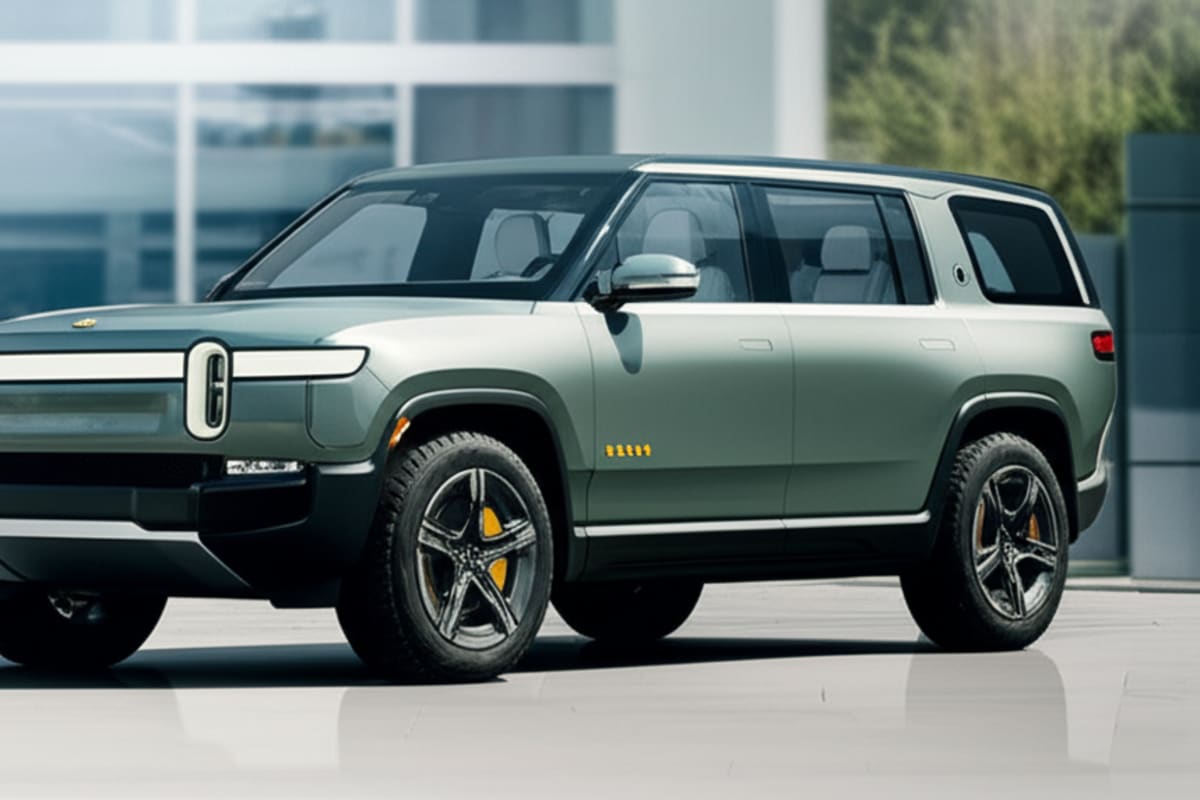Rivian CEO Bets Big on In-House Tech, AI, and Why CarPlay Won't Be in Your R2

Hello from Phnom Penh. As a journalist keenly observing the global automotive landscape, Rivian’s journey has always fascinated me.
Background
It’s a company that’s consistently challenged the status quo, carving out its own niche in the electrifying world of EVs.
Recently, a compelling interview with Rivian CEO RJ Scaringe on The Verge’s Decoder podcast (where Joanna Stern admirably filled in for Nilay Patel) offered a deep dive into the company’s strategic pivots, its conviction in proprietary technology, and the challenging road ahead
Coming off a week of discussing legacy automakers, this chat with Rivian – arguably Tesla's most formidable EV-only competitor in the U. – felt incredibly timely.
Scaringe, making his third appearance on the show, didn't shy away from the monumental issues facing the industry: tariffs, China’s burgeoning dominance, the ever-present question of EV pricing, and yes, even the occasional flat tire
More significantly, he laid out Rivian's ambitious roadmap for a future firmly built on a 'clean slate' of software and electronics, free from the encumbrances of traditional car manufacturing
This isn't just about making electric vehicles; it's about crafting an entirely new driving experience, one that resonates deeply with the evolving expectations of consumers worldwide, including right here in Southeast Asia
From Luxury to the Masses: The R2 RevolutionWhen Rivian first burst onto the scene with its R1T truck and R1S SUV, they were undeniably positioned as premium vehicles, often sporting price tags north of $90,000
Scaringe aptly described these as Rivian’s 'handshake with the world,' establishing a brand synonymous with enabling 'active lifestyles.
' Here in urban centers like Phnom Penh, while Rivians are still a rarity, the brand’s luxurious, adventure-ready image is certainly known among discerning enthusiasts
, these early models quickly found a strong niche among affluent suburban families, particularly in coastal areas.
But that exclusive approach is set for a dramatic shift with the introduction of the R2
Slated for early 2026 deliveries and starting at a much more accessible $45,000, the R2 represents Rivian's bold play for the mass market.
Scaringe’s vision is clear: "The goal is definitely to be much broader than an expensive electric vehicle company
" He’s remarkably confident they can translate their premium market success – currently holding the top spot for premium electric SUV sales in California and Washington, even outselling the Model X – to a significantly larger segment
He remarked, "If we can take even a fraction of the market share success that we’ve had at this premium price point…and translate that to the mass market product, the R2, we’d be really happy
" This strategic pivot is crucial for long-term sustainability and growth, signaling Rivian's intent to become a household name, not just a luxury emblem
The CarPlay Conundrum: A Matter of ConvictionNow, let's address the elephant in the room for many tech-savvy drivers: Apple CarPlay
My own experiences, like many consumers, often lead me to crave the seamless Apple experience in any infotainment system. Yet, Rivian's CEO is holding firm: no CarPlay.
And he articulates his conviction with unwavering clarity. Scaringe insists this isn't an anti-Apple stance.
In fact, he highlights a "great relationship with Apple," promising upcoming integrations like Apple Music, messaging, and even vehicle access via Apple Watch
However, for Scaringe, the core decision stems from a deep-seated desire to deliver a truly "seamless digital experience" where Rivian remains the central 'glue' for all applications
He argues that the act of bouncing between a native Rivian environment and a CarPlay 'bubble' inevitably creates a disjointed user experience.
More importantly, this stance is about laying the groundwork for profound AI integration
"Over the next 18 months, we’re going to see a lot of new features that, by necessity, are performing tasks or making decisions to connect different applications," he explained
"Knowledge of 'what’s the vehicle state
'… allows us to present a richer, better experience for you.
" It's a bold gamble, one he concedes might deter some potential buyers, but it's a calculated bet on a superior, deeply integrated, and AI-powered future
China's Shadow: Tariffs, Costs, and Global TechMy previous guest, Jim Farley of Ford, spoke candidly about China's BYD being the "700-pound gorilla" in the EV industry, particularly concerning their ability to produce lower-cost, high-tech vehicles
RJ Scaringe echoed this sentiment, dissecting the challenge into two critical components: cost structure and advanced technology
On the cost front, Scaringe acknowledged that while Chinese companies certainly innovate, their dramatic cost advantages often stem from "very low cost to capital
very low labor cost, very high labor availability," effectively creating compounded benefits across their entire supply chain
This phenomenon is particularly striking in Southeast Asia, where Chinese brands like BYD, NETA, and Wuling are rapidly gaining market share.
With aggressively priced and feature-packed EVs, they're pushing both established local and international manufacturers, including those operating in Cambodia and Thailand, to fundamentally rethink their strategies
However, for Rivian, the technological edge of Chinese EVs is an even greater concern
Similar to Tesla and Rivian, many Chinese EV companies have built advanced software and electronics platforms from a 'clean sheet' approach.
This stands in stark contrast to legacy OEMs that have historically outsourced much of these critical domains
Rivian, meanwhile, has taken its in-house software and electronics platform to a global stage, striking a massive $5. 8 billion software licensing deal with Volkswagen Group.
This pivotal move unequivocally demonstrates the strength and global appeal of US-developed EV technology.
While that specific deal excludes the Chinese market directly, its influence on global automotive software standards is undeniable
For Southeast Asian consumers, this means future Volkswagen vehicles in our region could indirectly benefit from Rivian's software prowess, raising the bar for integrated vehicle intelligence
Navigating the Bumps: Profitability and ReliabilityRivian's journey hasn't been without its share of bumps and detours
Launching right into the heart of a pandemic and battling severe supply chain crises, achieving consistent profitability has been a significant hurdle.
Scaringe candidly admitted, "It better improve, and I say that with a smile
" While the company did achieve positive gross margins in late 2024 and early 2025, Q2 2025 saw an unexpected dip due to a sudden export control on magnets from China, severely crippling motor production
"We went from 14,000 units produced in Q1 to around 6,000 in Q2," he revealed
However, with that control now lifted, he’s bullish on the second half of 2025, firmly believing that the R2's scale will be the "ignition" for covering operating costs and achieving structural cost advantages from their vertical integration
Then there's the question of reliability
Consumer Reports recently placed Rivian last in vehicle reliability, a point that was brought up directly during the interview.
Scaringe acknowledged this is an "absolute focus," attributing much of it to challenges faced with their early builds and the rapid scale-up process
The encouraging news. Even with those initial hiccups, Rivian boasts the number one spot for customer satisfaction.
"Imagine if our reliability gets to be best in class, coupled with all the product attributes. So, that’s our goal," he stated.
He stressed that the R2 represents a significant step-change in reliability, incorporating all the crucial lessons learned from the R1's production.
The Road Ahead: AI and Autonomous DrivingFor many, myself included, the ultimate aspiration for EVs extends to true autonomy
RJ Scaringe offered a fascinating glimpse into Rivian's strategy, highlighting a major paradigm shift in how self-driving systems are developed.
The era of purely rules-based planners is waning; the future, he asserts, lies in AI – specifically, large, multi-billion parameter neural networks that learn to drive
"The rate of improvement of these systems is going to be much higher," he predicted.
Rivian's Gen 2 vehicles, which debuted mid-2024, brought their entire perception stack (all sensors) in-house, coupled with a powerful new in-vehicle compute platform
And unlike Tesla's camera-only approach, Rivian embraces multi-sensor fusion: employing high-megapixel cameras, robust corner radars, and 3D imaging radar in the front
Lidar, Scaringe added, isn't ruled out, especially as its cost continues to plummet
The rationale is compelling: more data, earlier fusion, and diverse sensor modalities collectively lead to a more accurate and robust understanding of the world for the AI model, crucial for safe autonomous operation
The feature roadmap is ambitious yet meticulously planned: today's highway assist will evolve to hands-off, eyes-on capabilities on all roads next year, followed by turn-by-turn navigation
By 2027, Rivian aims for hands-off, eyes-off functionality in specific circumstances, such as highways. "That I think is a really big unlock because you start to get your time back," he said.
His bold prediction for the long term. By the early 2030s, it'll be "inconceivable to buy a new car and not have it perform at a very high level from a self-driving point of view.
"A Journalist's Take and the Road Ahead for ConsumersThe original interview's host mentioned her son, who dubbed RJ "Rivian Man. " As a parent myself, such endearing anecdotes stick.
And as a journalist, I was particularly interested in the concrete improvements mentioned, like the vastly improved maps thanks to a Google partnership – a relief to anyone who's struggled with in-car navigation
("Checked one box there
" RJ quipped). Rivian is clearly at a pivotal inflection point, strategically shifting from a high-end niche to a much broader mass market.
They're armed with a formidable brand, unwavering convictions about their proprietary technology, and a clear, compelling vision for an AI-driven future
It’s undeniably a tough, competitive road ahead, especially with the relentless global pressures from Chinese EVs impacting pricing and strategy, even for US-focused brands like Rivian
However, Scaringe's quiet confidence and strategic depth suggest Rivian is not just ready, but eager to accelerate.
What this all means for you, the consumer, whether you’re tracking the global EV landscape from the U
or from a bustling city in Southeast Asia, is a more dynamic, diverse, and technologically advanced EV market.
Rivian's aggressive push for affordability with the R2, coupled with its profound commitment to integrated AI and autonomous driving, sets a remarkably high bar for innovation
Even if you never purchase a Rivian yourself, their advancements will inevitably trickle down and influence what every automaker offers, from creature comforts to cutting-edge safety features
The future of driving, it seems, is poised to be significantly smarter, more integrated, and perhaps, a little less hands-on
And that, my friends, is something truly worth getting excited about, promising a richer and more efficient future for mobility across our region and beyond.
